Greywater for Food Gardens
Notes prepared by Adam Grubb, Very Edible Gardens 2025
What is greywater?
Greywater is used household water, primarily from the bathroom and laundry. It, of course, doesn’t include toilet water, which is referred to as ‘blackwater’. Kitchen sink water contains lots of oils and food particles which can clog up greywater systems and breed bacteria if allowed to sit – thus, it’s considered blackwater too.
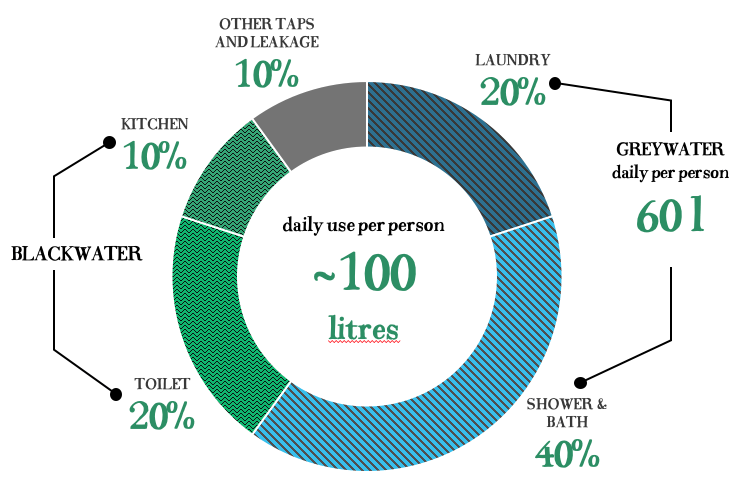
How much greywater do we produce?
The average Melbournian uses about 160 litres of water per day. But if you subtract evaporative cooling (which is non-recoverable, it evaporates!) and garden watering, it’s pretty close to 100 litres per day, with about 20 litres of laundry water and 40 litres of shower water available for greywater use per person. Your mileage may vary.
How much does your garden need?
A great place to estimate your garden’s water needs is www.smartgardenwatering.org.au.
More than half your watering happens in summer, so the amount of water required per day in summer is the critical figure if we want to know how much we garden we can keep healthy.
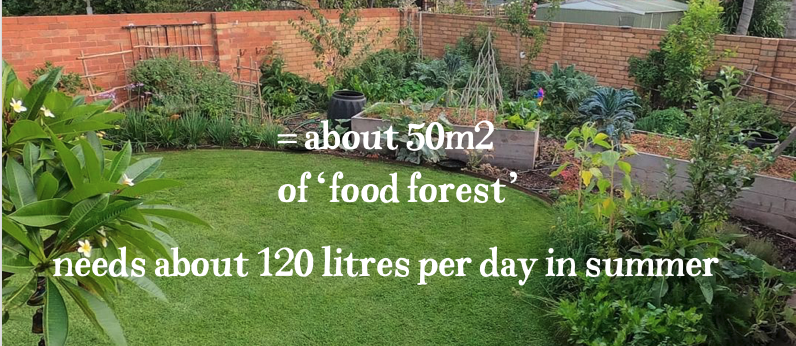
In example calculation for an underplanted orchard in Altona a 50m2 ‘food forest’ required about 120 litres of supplemental water per day in summer. That’s about the same as the greywater produced by two people! Sweet.
Pros and cons of greywater
Pros
- More reliable than rainwater
- It’s usually automatic
- Saves water
- Reduces load on sewer system
- Can be cheap
- Doesn’t take up much space
- Guilt free showers!
Cons
- Can be hard to access (newer houses especially)
- Some methods are expensive
- Can be require knowledge to DIY
- Must use certain cleaning / bathroom products
- Potential plant and soil damage
- Potential (but unlikely) health hazards
Greywater regulations
In Victoria, there aren’t any state wide restrictions on the use of untreated greywater. However, there may be local council regulations and guidelines. Always check council requirements before installing systems.
Health and safety
Untreated greywater can contain small amounts of human pathogens. It can also, if stored, breed bacteria. So, it’s important to follow these guidelines around using it.
- Keep it subsurface. Ensure pets, wildlife (and people) cannot drink or access the greywater.
- Keep it in your yard. Ensure greywater cannot leak into stormwater drains, waterways or into neighbouring properties.
- Don’t store it. Untreated greywater must not be stored longer than 24 hours.
- Don’t apply to vegetables. Do not use greywater to water veggie crops esp. those eaten raw or only cooked briefly.
- Avoid contamination. Do not use greywater that could have human waste contamination, e.g. water used to wash nappies. Don’t use greywater if any member of your household is suffering from gastroenteritis.
- Use greywater safe detergents. For the health and safety of soil and plants, use low phosphorous and low sodium laundry detergents. (Laundry liquids are almost always better than powders.)

Simple systems
The simplest greywater system is a bucket in the shower. If you only collect the warm up water it’s not even greywater. You can use it on vegetables etc.
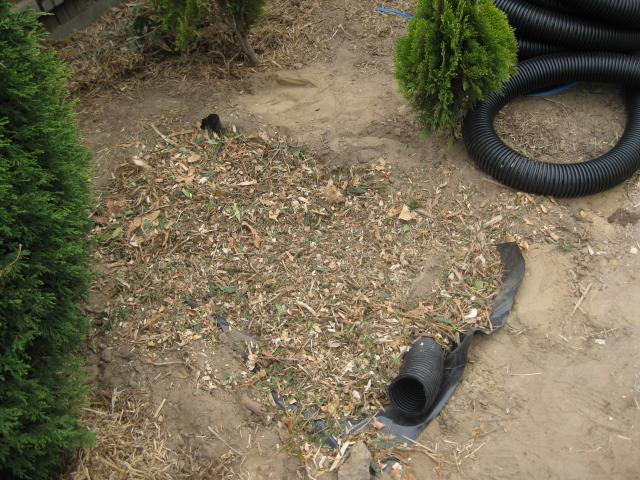
Mulch pits
A pit dug into the soil then filled with mulch, is a way to get greywater subsurface quickly, giving it time to infiltrate into the surrounding soil.
Mulch pits must be big enough that they don’t overflow.
In sandy soils they can be a bit smaller than in heavy clay soils, because clay soils take longer to drain. You can get an idea how fast your soil drains by digging a hole and filling it with water.

Simple laundry water systems
The simplest system involving mulch pits is an extension hose from the washing machine, that uses the power of the washing machine pump to get water into around the garden. You can buy ‘greywater hoses’ for this purpose. Don’t attach a regular garden hose! It’s too thin and will put too much stress on the washing machine pump. Don’t try to pump uphill too far either.
Simple shower systems
You can access shower water if you have access to external plumbing. It’s not always possible especially in newer houses which tend to have the plumbing running through the slab.
Because there’s no pump involved you need to have a constant fall in the pipes. So it’s only useful if your garden is significantly lower than the floor of your house.
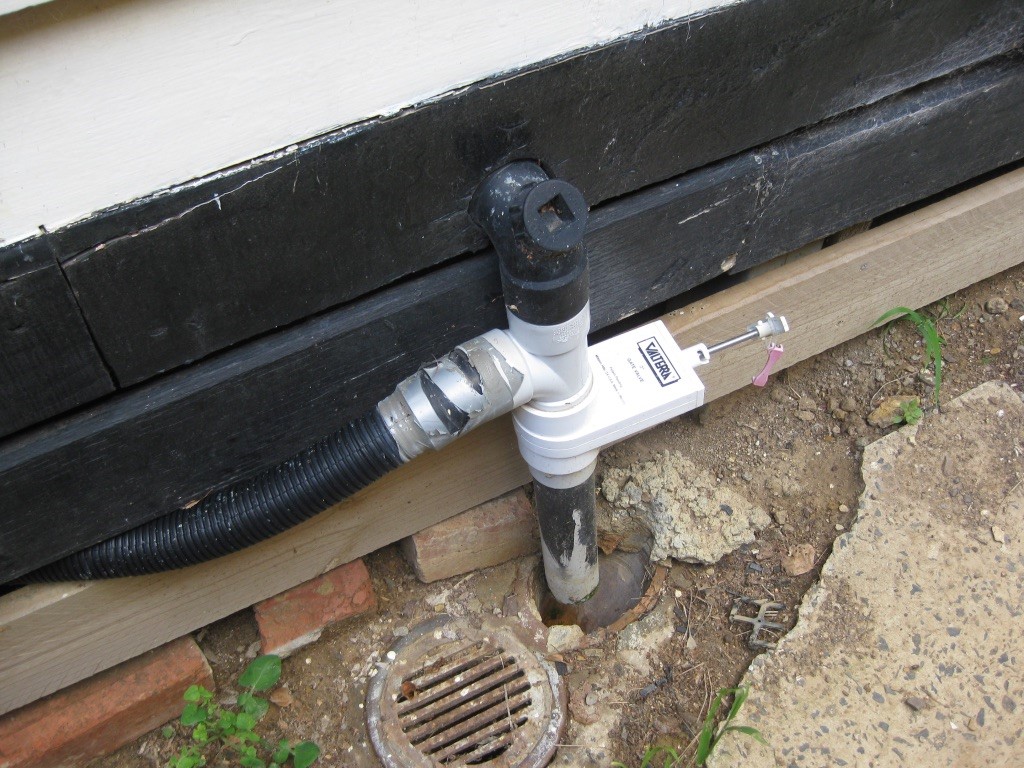
Although they are easy to install, greywater diversion valves should be installed by a plumber. There are products you buy called water reclaimers however which slide into the inspection hatch which you can legally (we think! It may be a bit of a ‘grey’ area) install yourself.
Again, your pipes can and should go to mulch pits.
Mid-tier systems
Laundry-to-landscape
Although it’s relatively low tech, the ‘laundry-to-landscape’ system invented by greywater pioneer Art Ludwig is good at distribution and very low maintenance. It uses the washing machine pump to pump – so the water is under a little bit of pressure. This means you aren’t just depending on gravity to distribute the water. You can use standard poly irrigation pipes and fittings which makes it pretty easy to get around the garden.

Once set up there’s not filter to clean and they rarely clog so it’s easy to forget they are there! Make sure if anyone in your household is using bleach or other harsh chemicals they are redirected to the sewer! We’ll say more about this in a bit.
Once set up there’s not filter to clean and they rarely clog so it’s easy to forget they are there! Make sure if anyone in your household is using bleach or other harsh chemicals they are redirected to the sewer! We’ll say more about this in a bit.
Image Source: CC BY 2.0, Sustainable Sanitation Alliance
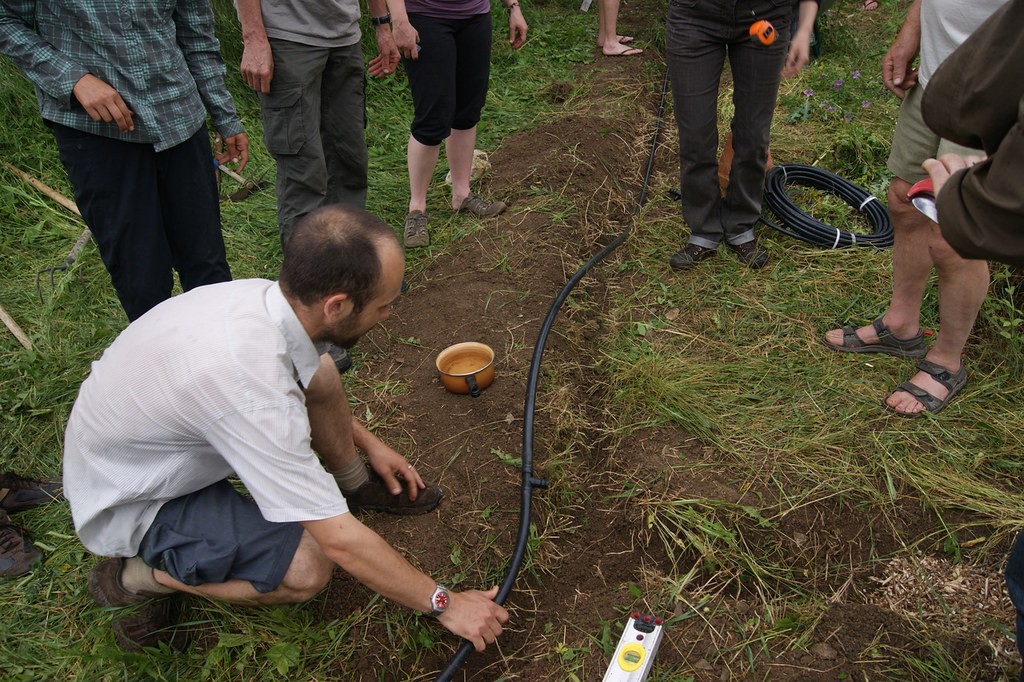
Mostly it’s as easy as Lego, but there are a few little tricks involved to make sure you don’t create a syphon and don’t put too much stress on the washing machine’s pump. To learn more about laundry-to-landscape system see the Further Resources section below.
Image Source: CC BY 2.0, Sustainable Sanitation Alliance
Branched drain systems
If your shower is higher than your garden and you can access your plumbing, you might be able to do a branched drain system. Unlike laundry-to-landscape above, it depends exclusively on gravity. That means the pipes must be larger pipes, the type designed for sewer or stormwater.

Fittings like this Y-junction are used flat to the ground to split the flow of water in two creating a ‘branch’. With multiple branches you can spread your greywater out across the garden, as long as there’s a downwards slope.
Branched drains are another system pioneered by Art Ludwig of Greywater Action in the US. The picture on the right is of someone carefully using a level to evenly split the flow of water in two directions. It can be pretty subtle to get it right!
Pit, filter and pump systems
If you get a plumber to install the full greywater system you’ll be getting an inground plastic pit, with a submersible pump, and filter. Water that comes out of these systems can be used in purple coloured (the international standard for recycled water) irrigation systems including ‘dripline’. These offer the best distribution system of anything mentioned, and can water gardens up hill from your house – but can cost up to $10,000 to install. If you do get one, make sure it has a self-flushing filter, otherwise you’ll need to clean really gross stuff out of it every few weeks!
What goes down the drain?
If you’re going to use greywater you need to make sure only the most eco-friendly laundry detergents and cleaning products go into the greywater system!
Laundry detergents can make your soil alkaline, increase its salinity, and make clay soils sticky and difficult to work with, due to excess sodium. But some laundry detergents are more than 100x worse than others. In general use liquids not powders. Use ones labelled greywater-safe or septic-safe. Excellent research is available thanks to Robert Patterson at www.lanfaxlabs.com.au on which detergents are best (although it hasn’t been updated since 2009).
In the shower, just try to not over-do hard soaps and harsh hair products like bleaches and you should be fine.
Around the home make sure bleaches and other strong cleaning products aren’t emptied down any drains attached to the greywater system!
Further resources
Website:
EPA Victoria – About Greywater
Here’s two great books and one video, unfortunately only available as a DVD.
Create an Oasis with Greywater by Art Ludwig
Greywater, Green Landscape by Laura Allen
Laundry to Landscape DVD by Art Ludwig


